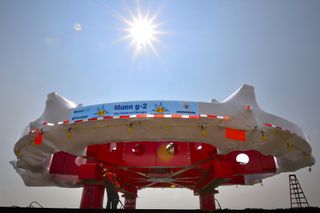Huge Electromagnet Nears End of Careful Cruise

A giant but delicate ring-shaped electromagnet glided past St. Louis earlier today (July 18), nearing the end of its long cruise from New York to the suburbs of Chicago, where it will be a centerpiece of a major physics experiment.
For almost a month now, the huge piece of machinery has been on the move. After the electromagnet was loaded onto a barge near its former home at Brookhaven National Lab on Long Island, it crept down the East Coast, around the tip of Florida, through the Gulf of Mexico, and then started making its way up the Mississippi, pushed along by tugboat. By the time it gets to its new home — Fermi National Accelerator Laboratory, or Fermilab, in Illinois — the unusual cargo will have traveled about 3,200 miles (5,000 kilometers).
At Fermilab, the electromagnet will be central to the muon g-2 experiment, an investigation into the nature of ultra-rare subatomic particles called muons, which exist for just 2.2 millionths of a second.
Earlier experiments at Brookhaven using the electromagnet suggested that muons did not behave as predicted by the Standard Model, the reigning theory of particle physics. Scientists are hoping to clear up this discrepancy at Fermilab, which is better equipped than Brookhaven to generate a more intense, pure beam of the particles.

Lab officials determined that this ocean-to-river route was the cheapest and safest way to get the storage ring to its new home. It has to be moved in one piece, and one wrong tilt or twist could irreparably damage the electromagnet's complex wiring.
The water-leg of the ring's journey is set to end this weekend, when the electromagnet will be transferred to specially adapted truck and travel to Fermilab slowly by road over three consecutive nights. The arrival is set for the afternoon of July 26, with a public celebration to greet the particle storage ring.
"A 50-foot-wide [15-meter-wide] electromagnet rolling down a road is really something to see," David Hertzog of the University of Washington, a spokesman for the muon g-2 experiment, said in a statement. "As excited as we are about the new physics this experiment may uncover, we're equally thrilled to see the magnet making its last few steps home."
Sign up for the Live Science daily newsletter now
Get the world’s most fascinating discoveries delivered straight to your inbox.
Follow Megan Gannon on Twitter and Google+. Follow us @livescience, Facebook & Google+. Original article on LiveScience.com.

